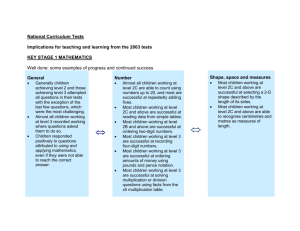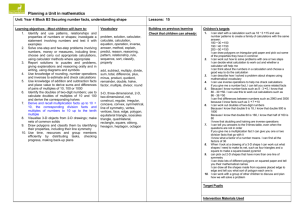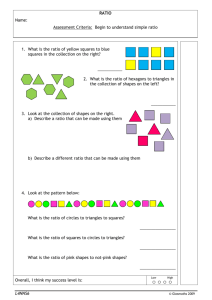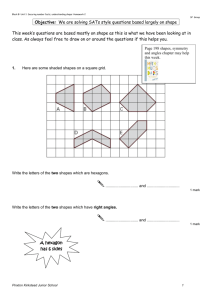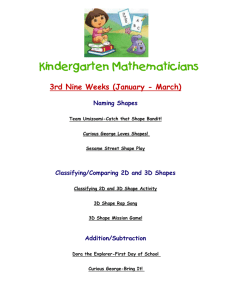Year 1 Block B - Securing number facts, understanding shape Unit 3
advertisement
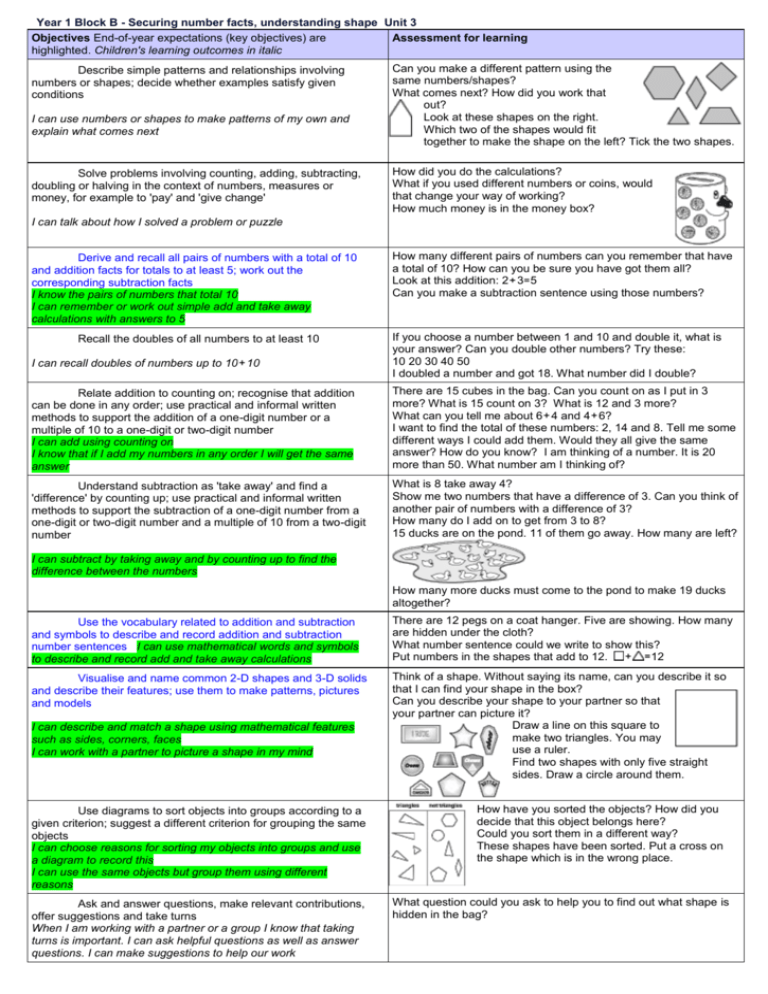
Year 1 Block B - Securing number facts, understanding shape Unit 3 Objectives End-of-year expectations (key objectives) are Assessment for learning highlighted. Children's learning outcomes in italic Describe simple patterns and relationships involving numbers or shapes; decide whether examples satisfy given conditions I can use numbers or shapes to make patterns of my own and explain what comes next Solve problems involving counting, adding, subtracting, doubling or halving in the context of numbers, measures or money, for example to 'pay' and 'give change' Can you make a different pattern using the same numbers/shapes? What comes next? How did you work that out? Look at these shapes on the right. Which two of the shapes would fit together to make the shape on the left? Tick the two shapes. How did you do the calculations? What if you used different numbers or coins, would that change your way of working? How much money is in the money box? I can talk about how I solved a problem or puzzle Derive and recall all pairs of numbers with a total of 10 and addition facts for totals to at least 5; work out the corresponding subtraction facts I know the pairs of numbers that total 10 I can remember or work out simple add and take away calculations with answers to 5 Recall the doubles of all numbers to at least 10 I can recall doubles of numbers up to 10 10 How many different pairs of numbers can you remember that have a total of 10? How can you be sure you have got them all? Look at this addition: 2 3 5 Can you make a subtraction sentence using those numbers? If you choose a number between 1 and 10 and double it, what is your answer? Can you double other numbers? Try these: 10 20 30 40 50 I doubled a number and got 18. What number did I double? Relate addition to counting on; recognise that addition can be done in any order; use practical and informal written methods to support the addition of a one-digit number or a multiple of 10 to a one-digit or two-digit number I can add using counting on I know that if I add my numbers in any order I will get the same answer There are 15 cubes in the bag. Can you count on as I put in 3 more? What is 15 count on 3? What is 12 and 3 more? What can you tell me about 6 4 and 4 6? I want to find the total of these numbers: 2, 14 and 8. Tell me some different ways I could add them. Would they all give the same answer? How do you know? I am thinking of a number. It is 20 more than 50. What number am I thinking of? Understand subtraction as 'take away' and find a 'difference' by counting up; use practical and informal written methods to support the subtraction of a one-digit number from a one-digit or two-digit number and a multiple of 10 from a two-digit number What is 8 take away 4? Show me two numbers that have a difference of 3. Can you think of another pair of numbers with a difference of 3? How many do I add on to get from 3 to 8? 15 ducks are on the pond. 11 of them go away. How many are left? I can subtract by taking away and by counting up to find the difference between the numbers How many more ducks must come to the pond to make 19 ducks altogether? Use the vocabulary related to addition and subtraction and symbols to describe and record addition and subtraction number sentences I can use mathematical words and symbols to describe and record add and take away calculations There are 12 pegs on a coat hanger. Five are showing. How many are hidden under the cloth? What number sentence could we write to show this? Put numbers in the shapes that add to 12. 12 Visualise and name common 2-D shapes and 3-D solids and describe their features; use them to make patterns, pictures and models Think of a shape. Without saying its name, can you describe it so that I can find your shape in the box? Can you describe your shape to your partner so that your partner can picture it? Draw a line on this square to make two triangles. You may use a ruler. Find two shapes with only five straight sides. Draw a circle around them. I can describe and match a shape using mathematical features such as sides, corners, faces I can work with a partner to picture a shape in my mind Use diagrams to sort objects into groups according to a given criterion; suggest a different criterion for grouping the same objects I can choose reasons for sorting my objects into groups and use a diagram to record this I can use the same objects but group them using different reasons Ask and answer questions, make relevant contributions, offer suggestions and take turns When I am working with a partner or a group I know that taking turns is important. I can ask helpful questions as well as answer questions. I can make suggestions to help our work How have you sorted the objects? How did you decide that this object belongs here? Could you sort them in a different way? These shapes have been sorted. Put a cross on the shape which is in the wrong place. What question could you ask to help you to find out what shape is hidden in the bag? Year 2 Block B - Securing number facts, understanding shape Unit 3 Objectives Assessment for learning End-of-year expectations (key objectives) are highlighted Children's learning outcomes in italic Describe patterns and relationships involving numbers or shapes, make predictions and test these with examples Investigate different ways of making 50p using only silver coins. How many different ways can you find? Record each different way of doing it. I can describe and continue the pattern for a set of numbers or shapes Solve problems involving addition, subtraction, multiplication or division in contexts of numbers, measures or pounds and pence Look at the number line. It shows the sum that Peter did. I can decide which calculations are needed to solve a two-step word problem Which of these sums did Peter do? Tick it. 5 7 2 14 5 6 3 14 5 5 4 14 5 8 1 14 Ella's dad washes some cars. He uses 12 buckets of water. Each bucket has 5 litres of water. How many litres of water does he use altogether? Show me how to use cubes to work out the answer. Now show me how to work out the answer using a number line. There are 60 sweets in a bag. 20 sweets are red. 16 sweets are yellow. The rest are green. How many sweets are green? Show me how you worked out the answer. Make up a story that would mean that you needed to work out 2 9 then add 16. Derive and recall all addition and subtraction facts for each number to at least 10, all pairs with totals to 20 and all pairs of multiples of 10 with totals up to 100 Look at this number sentence: 20. What could the two missing numbers be? What else? Can you tell me all the pairs of numbers that make 20? I know which pairs of numbers make 20 I know all the pairs of multiples of 10 that make 100 Understand that halving is the inverse of doubling and derive and recall doubles of all numbers to 20, and the corresponding halves I'm thinking of a number. I've halved it and the answer is 15. What number was I thinking of? Explain how you know. I know the doubles of all the numbers up to 20 Derive and recall multiplication facts for the 2, 5 and 10 times-tables and the related division facts; recognise multiples of 2, 5 and 10 Sita worked out the correct answer to 9 5. Her answer was 45. Show how she could have worked out her answer. Harry worked out the correct answer to 20 5. His answer was 4. Show how he could have worked out his answer. I know my 2, 5 and 10 times-tables and can work out the division facts that go with them I can tell if a number is a multiple of 2, 5 or 10 Use knowledge of number facts and operations to estimate and check answers to calculations I can check answers to calculations involving doubling by halving the answer Visualise common 2-D shapes and 3-D solids; identify shapes from pictures of them in different positions and orientations; sort, make and describe shapes, referring to their properties I can match familiar solids to their pictures Ling wants to check her answer to this addition. 45 28 73 Which of these tells Ling that her answer is correct? A 73 45 118 B 73 - 45 28 C 28 73 91 D 45 - 28 17 How can I check the answer to half of 28 is 14? Look at these two shapes. What is the same about them? What is different? Watch as I slowly reveal a shape from behind a 'wall'. What could it be? How do you know? What could it not be? Why? This shape is made from four identical squares touching edge to edge. Make different shapes from four identical squares touching edge to edge. Record each different shape that you make. Tell real or imagined stories (using conventions of familiar story language) I know my 2, 5 and 10 times-tables and can make up a story to fit a calculation and tell it to a group or to the class Tell me a story that would mean that you had to work out this calculation: 45 - 8 37 Year 3 Block B - Securing number facts, understanding shape Unit 3 Objectives Assessment for learning End-of-year expectations (key objectives) are highlighted Children's learning outcomes in italic Solve one-step and two-step problems involving numbers, money or measures, including time, choosing and carrying out appropriate calculations I can solve a problem by writing down what calculation I should do A box holds 35 nuts. John eats 17 nuts. How many nuts are left? How many people can have 5 nuts each? How many nuts are there in 3 boxes? What calculation did you do each time? Anna has a 50p coin and three 20p coins. How much is this altogether? Show how you worked out the answer. How did you decide what calculations to do? I can draw a picture to help make sense of a problem A spider has eight legs. How many legs do six spiders have? How did you find the answer? What did you write down or draw? Anna is 118 cm tall. Her brother is 97 cm tall. How much taller is Anna? Draw a picture or use a number line to help you to find the answer. Ali had 50 apples. He sold some and then had 20 left. Which of these is a number sentence that shows this? A 20 50 B 20 50 C 50 20 D 50 20 Identify patterns and relationships involving numbers or shapes, and use these to solve problems What is special about the shaded numbers in the grid? Suggest some other numbers that would be shaded. Represent the information in a puzzle or problem using numbers, images or diagrams; use these to find a solution and present it in context, where appropriate using .p notation or units of measure I can find numbers or shapes that match a property Look at this set of 2-D shapes. Identify the shapes in the set that have one right angle, two right angles, more than two right angles. Read and write proper fractions (e.g. , ), interpreting the denominator as the parts of a whole and the numerator as the number of parts; identify and estimate fractions of shapes; use diagrams to compare fractions and establish equivalents What fraction of this shape is shaded? Can you say this fraction in another way? Roughly how much of this cake has been eaten? I can say what fraction of a shape is shaded Derive and recall all addition and subtraction facts for each number to 20, sums and differences of multiples of 10 and number pairs that total 100 I know and use all addition and subtraction facts to 20 I can find what to add to a number to make 100 Tell me some addition and subtraction facts with the answer 12. What is 12 7? What is 120 70? How did you find the answer? Rick says 38 72 100. Is he right? What mistake has he made? Derive and recall multiplication facts for the 2, 3, 4, 5, 6 and 10 times-tables and the corresponding division facts; recognise multiples of 2, 5 or 10 up to 1000 I know the 2, 3, 4, 5, 6 and 10 times-tables and use them for division I recognise multiples of 2, 5 and 10 Two numbers multiply to make 20. What could they be? If you cannot remember the 4 times-table, how could you work it out? Find a number between 10 and 20 that gives a remainder when divided by 3. Find a number that is a multiple of 2 but is not a multiple of 10. Use knowledge of number operations and corresponding inverses, including doubling and halving, to estimate and check calculations I can estimate and check my calculations Half of 38 is 19. Use the word "double"to make a sentence with the same numbers. Find which two of these calculations are wrong: A Half of 34 is 18 B 35 19 16 C 35 5 12 Relate 2-D shapes and 3-D solids to drawings of them; describe, visualise, classify, draw and make the shapes I dip a triangular prism in paint and make a print of each face. What shapes will I print? I can describe the properties of shapes I can sort shapes using different properties Use cubes to make these shapes: Use a set-square to draw right angles and to identify right angles in 2-D shapes; compare angles with a right angle; recognise that a straight line is equivalent to two right angles I can say whether the angles of a 2-D shape are right angles or whether they are smaller or bigger Find a quadrilateral that has two angles that are smaller than right angles and two that are bigger than right angles. Which shapes always have four right angles? Draw two lines to complete the square. Develop and use specific vocabulary in different contexts I can picture a shape in my head when it is described to me I can describe a shape so that others can draw it Imagine two squares the same size placed so that they touch side to side. What shape does this make? Year 4 Block B - Securing number facts, understanding shape Unit 3 Objectives End-of-year expectations (key objectives) are highlighted Children's learning outcomes in italic Assessment for learning Identify and use patterns, relationships and properties of numbers or shapes; investigate a statement involving numbers and test it with examples Name a multiple of 6 that is also a multiple of 9. Using the numbers 6, 8 and 48, create some sentences using the vocabulary product, factor, multiplied by and multiple of. Here are some polygons. Decide on a property and classify them according to your property. Explain your decisions to me. What colour is each shape? Write it on the shape. Clues Red is not next to grey. Blue is between white and grey. Green is not a square. Blue is on the right of pink. I can start with a calculation such as 18 3 15 and use number patterns to create a family of calculations with the same answer: 180 30 150 190 40 150 200 50 150 I can draw polygons on triangular grid paper and pick out some of the properties they have in common Solve one-step and two-step problems involving numbers, money or measures, including time; choose and carry out appropriate calculations, using calculator methods where appropriate I can work out how to solve problems with one or two steps I can decide what calculation to work out and whether a calculator will help me. I can think about the numbers in a calculation and choose a good way to do the calculation Report solutions to puzzles and problems, giving explanations and reasoning orally and in writing, using diagrams and symbols I can describe how I solved a problem about shapes using mathematical vocabulary Use knowledge of rounding, number operations and inverses to estimate and check calculations I can use inverse operations to help me check calculations If you give me a number fact, I can tell you some related facts Sort these problems into those you would do mentally and those you would do with pencil and paper. Explain why. John wanted to use his calculator to add 463 and 319. He entered 263 319 by mistake. What could he do to correct his mistake? A Add 200. B Add 2. C Subtract 2. D Subtract 200. This grid has two shaded shapes. Leon says: 'Shape A has a larger area than shape B.' Explain how he could have worked this out. 6 7 13. Write three other facts that you can work out from the addition fact. 48 8 6. Write three other facts that you can work out from the division fact. Write a calculation that you could do to check that the answer to 53 is 212. 4 Use knowledge of addition and subtraction facts and place value to derive sums and differences of pairs of multiples of 10, 100 or 1000 Because I know number facts such as 8 - 3 5, I know that 80 - 30 50. I can use this to work out calculations such as 86 - 36 50. I can find differences between numbers such as 2993 and 3000 because I know facts such as 3 7 10 Which three numbers in this list have a sum of 190? 10 30 50 70 90 How did you work it out? Which pairs of these numbers have a difference of 60? 190 30 70 130 90 How did you work it out? Identify the doubles of two-digit numbers; use to calculate doubles of multiples of 10 and 100 and derive the corresponding halves I can work out doubles of two-digit numbers. Because I know that double 9 is 18, I know that double 900 is 1800. Because I know that double 80 is 160, I know that half of 160 is 80. I know that doubling and halving are inverse operations What are the missing numbers in this sequence? Derive and recall multiplication facts up to 10 10, the corresponding division facts and multiples of numbers to 10 up to the tenth multiple I can tell you answers to the 9 times-table, even when the questions are not in order. If you give me a multiplication fact I can give you one or two division facts that go with it. I know what a factor of a number means. I can find all the factors of 36 If you count in nines from zero, which digits change? How? Why do they change like this? Show me the pattern on the 100-square. How does the pattern help you to work out, say, six nines? How can you build the 9 times-table from the 3 and 6 times-tables? If you know 4 9 36, how does this help you to work out 36 9? What are the missing numbers in this number sentence? Are there any other possibilities? 18. What is the missing number in this number sentence? 9 54. How do you know? Visualise 3-D objects from 2-D drawings; make nets of common solids When I look at a drawing of a 3-D shape I can work out what shapes I need to make its net, such as four triangles and a square to make a square-based pyramid Match 3-D shapes to pictures of them. There are three shapes in a row. What order are they in and what colour are they? The cube is in the middle. The pink shape is not on the right. The red shape is next to the pyramid. The cone is not blue. Draw polygons and classify them by identifying their properties, including their line symmetry I can pick out 2-D shapes that have more than one line of symmetry. I can draw lots of different polygons on squared paper and tell you their mathematical names I can draw all the shapes made from squares placed edge to edge and tell you what sort of polygon each one is A shape has four right angles. It has four sides which are not all the same length. What is the name of this shape? Sort a set of polygons using this sorting diagram. Complete the number pattern. Here are five shapes on a square grid. Which two shapes have a line of symmetry? Use time, resources and group members efficiently by distributing tasks, checking progress, making back-up plans I can work with a group of other children to discuss and plan how we will solve a problem I want you to work in a group to solve this problem. You have 45 minutes. Decide how you will work together and share the tasks. Make sure you ask someone to be the timekeeper to keep a check on your progress. Year 5 Block B - Securing number facts, understanding shape Unit 3 Objectives End-of-year expectations (key objectives) are highlighted Children's learning outcomes in italic Assessment for learning Explore patterns, properties and relationships and propose a general statement involving numbers or shapes; identify examples for which the statement is true or false Two square tiles are placed side by side. How many tiles are needed to surround them completely? I can suggest a general statement and test whether it is true by investigating examples What if three square tiles were laid side by side? Four tiles? Five tiles? How many tiles would be needed if 100 tiles were laid side by side? Explain your answer. 'A number that ends in the digits 52 is always divisible by 4.' Give me an example where the statement is true. Can you find an example where the statement is false? Why not? Represent a puzzle or problem by identifying and recording the information or calculations needed to solve it; find possible solutions and confirm them in the context of the problem I can split a word problem into steps and work out what calculation to do for each step. I can explain what the answer to each step tells me I recognise when there may be more than one solution to a problem and try to find them all Use knowledge of place value and addition and subtraction of two-digit numbers to derive sums and differences and doubles and halves of decimals (e.g. 6.5 2.7, half of 5.6, double 0.34) I can add/subtract decimals in my head by using a related two-digit addition or subtraction I can find the double or half of a decimal by doubling or halving the related whole number You need six drinking straws each the same length. Cut two of them in half. You now have eight straws, four long and four short. You can make two squares from the eight straws like this. Arrange your eight straws to make three squares, all the same size. Draw a diagram to show your solution. Which of these subtractions can you do without any jottings? How did you find the difference between these two numbers? Talk me through your method. Find half of 92. Use your answer to find half of 0.92. Explain the relationship between the two calculations. What number added to 0.72 gives 1? How do you know? What number lies exactly halfway between 0.48 and 0.74? How did you work this out? I think of a number, halve it, then add 0.6. I get the answer 5.2. What number did I start with? How did you work out your answer? Recall quickly multiplication facts up to 10 10 and use them to multiply pairs of multiples of 10 and 100; derive quickly corresponding division facts I can use tables facts to multiply multiples of 10 and 100 and to find linked division facts What tips would you give someone who had forgotten the 7 times-table to help them to work it out? What other links between times-tables are useful? Find two numbers with a product of 1500. What other pairs can you find? Find different ways of completing this calculation: 240 Use knowledge of rounding, place value, number facts and inverse operations to estimate and check calculations Before I solve a word problem, I work out an estimate for the answer 417 895 men and 176 243 women attended a football match. Roughly, how many people attended altogether? Suggest a multiplication problem that will have an answer close to 2000. Use efficient written methods to add and subtract whole numbers and decimals with up to two places How did you find the difference between these two numbers? Talk me through your method. Make up an example of an addition/subtraction involving decimals that you would do in your head and one you would do on paper. Explain why. What could the two missing digits be? 62 95 757 I can explain each step when I write addition and subtraction calculations in columns Use a calculator to solve problems, including those involving decimals or fractions (e.g. to find of 150g); interpret the display correctly in the context of measurement I can use a calculator to find missing numbers in calculations. I use inverse operations and number facts to help me You have been using your calculator to find an answer. The answer in the display reads 5.6. What might this mean? You save 1.35 per week. How many weeks is it before you can buy a book costing 18.49? Explain how you used your calculator to work out the answer. Identify, visualise and describe properties of rectangles, triangles, regular polygons and 3-D solids; use knowledge of properties to draw 2-D shapes and identify and draw nets of 3-D shapes Tell me some facts about rectangles. Give me some instructions to get me to draw a rectangle. What is the same about a square and a rectangle? What might be different? Is it possible for a quadrilateral to have exactly three right angles? Why not? Imagine you have a paper square and a pair of scissors. Imagine cutting off a corner of the square in one straight cut. Without saying anything, quickly draw the shape you cut off. Now draw the shape you have left. Compare your two shapes with the rest of your group. What are the names of your two shapes? Describe how you would draw a net for a tetrahedron. I use mathematical vocabulary to describe the features of a 2-D shape. I always say whether any angles in the shape are equal I use the properties of 3-D shapes to draw their nets accurately Identify different question types and evaluate impact on audience I know that when my teacher asks certain mathematical questions there may be more than one answer. I try to think of all the possible answers What is the difference between these two questions? What is the product of 12 and 7? Tell me all the factor pairs of 84. Understand the process of decision making I can explain why I decided to use a particular method to solve a problem. I can describe what was special about the problem that prompted my decisions Why did you decide to use a mental/written/calculator method for this calculation? Why did you decide to change all the units to metres rather than centimetres? Why did you decide to use the scales rather than the balance? Year 6 Block B - Securing number facts, understanding shape Unit 3 Objectives End-of-year expectations (key objectives) are highlighted Children's learning outcomes in italic Assessment for learning Tabulate systematically the information in a problem or puzzle; identify and record the steps or calculations needed to solve it, using symbols where appropriate; interpret solutions in the original context and check their accuracy Imagine you have 25 beads. You have to make a three-digit number on an abacus. You must use all 25 beads for each number you make. How many different three-digit numbers can you make? How can you be sure that you have counted them all? How will you organise the information in this problem? Two boys and two girls can play tennis. Yasir said: 'I will only play if Holly plays.' Holly said: 'I won't play if Ben is playing.' Ben said: 'I won't play if Luke or Laura plays.' Luke said: 'I will only play if Zoe plays.' Zoe said: 'I don't mind who I play with.' Which two boys and which two girls play tennis? I can use a table to help me solve a problem I can identify and record what I need to do to solve the problem, checking that my answer makes sense and is accurate Represent and interpret sequences, patterns and relationships involving numbers and shapes; suggest and test hypotheses; construct and use simple expressions and formulae in words then symbols (e.g. the cost of c pens at 15 pence each is 15c pence) I can describe and explain sequences, patterns and relationships I can suggest hypotheses and test them I can write and use simple expressions in words and formulae Draw the next two terms in this sequence: Describe this sequence to a friend using words. Describe it using numbers. How many small squares would there be in the 10th picture? I want to know the 100th term in the sequence. Will I have to work out the first 99 terms to be able to do it? Is there a quicker way? How? How would you change an amount of money from pounds sterling to euros? Record it for me using symbols. Use knowledge of multiplication facts to derive quickly squares of numbers to 12 12 and the corresponding squares of multiples of 10 I can say the squares of numbers to 12 12 and work out the squares of multiples of 10 How many squares of multiples of 10 lie between 1000 and 2000? How many lie between 1000 and 10 000? Use knowledge of place value and multiplication facts to 10 10 to derive related multiplication and division facts involving decimals (e.g. 0.8 7, 4.8 6) I can use my tables to work out decimal facts like 0.4 8 and 5.6 7 Which of these are incorrect? 56 0.7 8 56 0.7 80 0.7 0.8 6.6 Explain how you know using words or diagrams. Recognise that prime numbers have only two factors and identify prime numbers less than 100; find the prime factors of twodigit numbers I can tell you all the prime numbers up to 100 and find the prime factors of other numbers Investigate which numbers to 30 have only one distinct prime factor (prime numbers, squares of prime numbers, cubes of prime numbers). Predict what numbers to 60 will have only one distinct prime factor when you test them. Use a calculator to solve problems involving multi-step calculations Which part of your problem will you solve mentally? Which part will you solve using a calculator? My calculator shows: I can use a calculator to solve problems with more than one step My question was about pounds. 0.35 means ... pence. My question was about litres. 0.35 means ... millilitres. My question was about metres. 0.35 means ... centimetres. Use approximations, inverse operations and tests of divisibility to estimate and check results I can estimate and check the result of a calculation Describe, identify and visualise parallel and perpendicular edges or faces; use these properties to classify 2-D shapes and 3-D solids I can identify 3-D shapes with perpendicular or parallel edges or faces Make and draw shapes with increasing accuracy and apply knowledge of their properties I can make and draw shapes accurately Use a range of oral techniques to present persuasive arguments and engaging narratives I can listen to the ideas of others, making sure that I respond to their ideas when I make my next statement Is this calculation correct? How do you know? What inverse operation could you use to check this result? I multiplied two odd numbers and my answer was 186. Explain why I cannot be correct. Should the answer be a multiple of 6? How could you check? This sequence of numbers goes up by 40 each time. 40 80 120 160 200 ...This sequence continues. Will the number 2140 be in the sequence? Explain how you know. Imagine a triangular prism. How many faces does it have? Are any of the faces parallel to each other? How many pairs of parallel edges has a square-based pyramid? How many perpendicular edges? Look at these 3-D shapes (e.g. a cuboid, tetrahedron, square-based pyramid and octahedron). Show me a face that is parallel to this one. Which face is perpendicular to this one? What can you tell me about the faces of a cuboid? Why are so many packing boxes made in the shape of a cuboid? Which of these shapes is incorrectly placed on this Carroll diagram? Change the criteria so the shapes are correctly sorted according to their properties. Use your ruler and protractor. Draw the net of a regular tetrahedron with edges of 6 cm. Use compasses to draw a circle. Use a ruler and protractor to draw a regular pentagon with its vertices on the circumference of the circle. Tell me an example of a circular object that would have a radius of about 5 cm. What about 50 cm? 500 cm? In your group, consider the sum of five numbers in a straight line on the 100-square. What do you notice? Think about this problem and how to solve it. Take turns to contribute one idea for the group to discuss.

